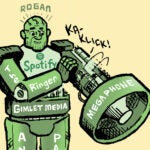 “Data-Driven Thinking” is written by members of the media community and contains fresh ideas on the digital revolution in media.
“Data-Driven Thinking” is written by members of the media community and contains fresh ideas on the digital revolution in media.
Today’s column is written by Lauren Moores, vice president of analytics at Dstillery.
Wearables are the latest consumer tech fad. But if you think about it, mobile phones were the first “wearable.” They became smarter with the Blackberry and more fashionable with the iPhone, albeit more unwieldy.
Many of us have since adopted non-phone wearable gadgets, including Fitbit, Nike Fuelband and Samsung Gear, or know someone who has. More than 17 million wearable bands are expected to ship this year, according to a forecast by Canalys.
Adoption is only going to increase as different kinds of devices hit the market. Google Glass is now available commercially to anyone with $1,500 to spend. Wearable startup companies RingBlingz, Trellie and Cuff are working on fashionable wearables that send social alerts, texts and phone calls through jewelry that is much more affordable.
As an evolution from mobile devices, wearables allow us to be connected to the people and things we care about in a more practical way than phones alone allow. What I love about wearables is that they enable the next phase in data: personalized data, which we call quantified self-data, or the data that knows you.
The use of this data is still in its infancy, as both manufacturers and consumers figure out the best way to use these devices. As a start, we are using Fitbit and Fuelbands to track personal fitness goals and to share progress with personal trainers or our social networks. For early invitees, Google Glass is being used for a myriad of things, including accessing apps like Strava, mapping running and biking trips, answering texts, taking photos and getting news updates.
As consumers and device manufacturers figure out the best uses for wearables, marketers are trying to assess what these new devices mean to them. In a world where the cookie provides a diminished view of consumers, quantified self-data is the next frontier to provide marketers a strong signal on audience behaviors. However, not only do we need to define what data can be used in a privacy-friendly manner, we also need to identify what data provides signal and, more importantly, if it is scalable.
Brands are just beginning to explore the usage of quantified self-data. Kantar Health, for example, sees a lot of potential in how data from wearables will help evolve health care over the next decade. We shouldn’t look at quantified self-data by itself, but should add mobile and quantified survey data to understand the whole picture, advised Brian Mondry, Kantar Health’s vice president of integrated strategies and digital solutions, at the MRMW Conference. The company is exploring “womb-to-tomb” data, which explores lifetime habits on the impact of health.
General Mills, which has already made a commitment to mobile, revealed at the conference that it, too, is experimenting with these wearable data streams.
It is still too early to tell what these devices can and will mean for marketers, as consumers themselves barely scratch the surface with adoption. As marketers, we’ll have to monitor this market closely to see if and where the opportunity exists to tap into the data. We might even see changes in how the market is defined.
I predict that the term “wearables” is temporary. Why distinguish between different mobile devices that consumers use as different channels? The channel itself is personal, however it is carried.
The point is that it knows you, and stays with you.
Follow Lauren Moores (@lolomoo), Dstillery (@dstillery) and AdExchanger (@adexchanger) on Twitter.












